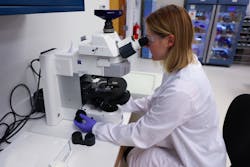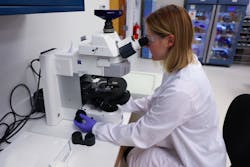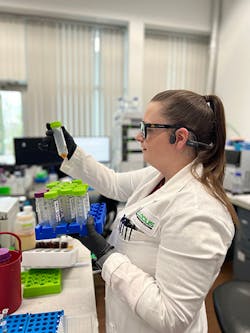Chemical Processing Notebook: Breaking Down Biomanufacturing
SOLON, OHIO -- The presence of 15,000-gallon fermentation tanks, towering within this suburban Cleveland production facility, might bring to mind a brewery. But the Locus Fermentation Solutions complex in Solon, Ohio, isn’t making the latest craft beer. The company, located about 20 miles southeast of downtown Cleveland, is a biomanufacturer producing bio-based surfactants for various industries, including the chemical sector.
Locus is one of several start-ups scaling production in the biomanufacturing space. In July, Locus announced plans to expand its operations by 100,000 square feet with two new facilities. The increased production capacity will help the company meet growing demand for biosurfactants. This includes an exclusive distribution agreement with Dow to supply biosurfactants for the chemical company’s global home and personal care markets.Biomanufacturing has gained increased attention from industry and government in recent years. In a March 2023 report, the Biden administration referred to it as a promising approach for producing recyclable polymers, which could replace over 90% of current plastics, decrease methane emissions from agriculture by capturing biogas, and promote the development of eco-friendly chemicals using bio-based raw materials.
What is Biomanufacturing?
Biomanufacturing involves the engineering of biological systems, such as microorganisms, animal or plant cells and enzymes, to produce materials used in different products.
The technology is not new. It’s been used to manufacture antibiotics and organic compounds, such as citric acid and lactic acid, most of which is has been produced outside the U.S. since the 1960s, says Gregory Stephanopoulos, W.H. Dow Professor of Chemical Engineering and Biotechnology at MIT.
How Does Biomanufacturing Differ from Chemical Synthesis?
As Stephanopoulos explains, traditional chemical production occurs in a reactor using fossil fuels as a feedstock. Of course, this process has sustainability and energy efficiency implications for chemical producers.
“Biomanufacturing offers the option of making the same products using renewable resources because in biomanufacturing the feedstock is basically glucose or some kind of a plant product,” Stephanopoulos says.
Locus, for example, develops biologicals from various organisms, including fungal spores and yeast. For agricultural products, the process begins in a lab with a cell culture to that grows in a small flask before moving to a larger flask and then a fermenter. The material then moves to a dryer, after which spores are collected and packaged into different formulations designed to increase crop yields. In a separate building, the company converts a metabolite excreted from yeast into a product for oil, gas and mining extraction.
Will biomanufacturing compete with or replace traditional chemical production?
Locus co-founder and CEO Andrew Lefkowitz says his company can help the existing chemical industry improve on its existing processes and products. “Part of our technology is to boost the efficacy of existing chemicals,” he says. For instance, in the mining industry, biosurfactants have unique adsorption properties that, when used in conjunction with existing extraction solutions like sulfuric acid, can help recover more minerals, notes Teresa DeJohn, the company’s public relations and marketing director. It’s also a potentially less-toxic replacement for certain substances, like 1, 4 dioxane, in some chemical formulations, the company says.
If biomanufacturing is so promising, why don’t we see more large-scale production?Stephanopoulos asserts that the main impediments to rapid adoption are cost and a lack of government incentives. The big issue is that the playing field is not level.
“The chemical industry uses fossil fuels, which are cheap. It uses processes that were developed 50 years ago and more, and they are (using) totally depreciated capital, so they have no capital cost. They have been optimized because they have been operating for many decades, so on the basis of this, they are very, very competitive.” He adds that policy changes that encourage more sustainable production are needed to encourage a shift toward biomanufacturing. Another potential hurdle is the capital cost to scale production.
Many traditional fermentation facilities often use extremely large fermenters that require large amounts of infrastructure to scale, says Scott Weber, vice president of production at Locus. This method involves fewer fermenters, but they come with a higher initial capital investment, and the construction and optimization of the facilities can span several years, he says. Locus employs a modular fermentation strategy, making use of a larger quantity of smaller fermenters, which enables the company to expedite its transition to commercial production.
“Our facilities can be built and running in a fraction of the time,” Weber explains. “While they may require more OPEX, they have much lower CAPEX with no negative impact on bottom line. This approach also results in faster scaling of the biologicals, more efficient productivity and allows us more agility or adaptivity based on market needs.”
About the Author
Jonathan Katz
Executive Editor
Jonathan Katz, executive editor, brings nearly two decades of experience as a B2B journalist to Chemical Processing magazine. He has expertise on a wide range of industrial topics. Jon previously served as the managing editor for IndustryWeek magazine and, most recently, as a freelance writer specializing in content marketing for the manufacturing sector.
His knowledge areas include industrial safety, environmental compliance/sustainability, lean manufacturing/continuous improvement, Industry 4.0/automation and many other topics of interest to the Chemical Processing audience.
When he’s not working, Jon enjoys fishing, hiking and music, including a small but growing vinyl collection.
Jon resides in the Cleveland, Ohio, area.



